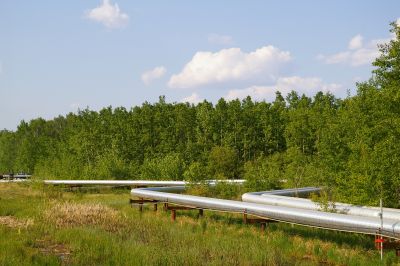February 25, 2025
Joint Letter to NDP Leader and MLAs Re: Public inquiry into the Alberta Energy Regulator
The attached letter (link below) was submitted on February 25, 2025, to the leader of…

Alberta is criss-crossed by more than 400,000 kilometres of pipeline, of which 85% are oil and gas pipelines.
Pipeline systems play a vital role in delivering the energy demanded by North Americans—due to their sheer number and distance covered as well as the considerable environmental and human health risks, pipelines must be better planned, managed and regulated.
A pipeline corridor (or right-of-way) is the area cleared to accommodate pipe diameter, and construction, maintenance and regulation activities. These corridors generate a significant developmental footprint upon the landscape. Typical corridors are between 15 and 18 metres in width, while larger pipelines may require corridors up to 45 metres wide.

Cold Lake pipeline (C. Campbell)
Alberta Wilderness Association (AWA) believes pipelines pose significant risks to human and environmental health. Pipelines must be built to the highest possible standards of safety. Pipelines must be routed to avoid impacts to environmentally significant areas including regionally designated areas, protected areas, critical wildlife habitat, intact fragments of grasslands and parklands natural landscapes, and AWA areas of concern, as depicted on our Wild Alberta map. The use of best management practices to minimize disturbance is essential and corridor access must be monitored and controlled through locked gates. Effective monitoring and harsh penalties for noncompliance or environmental damage is imperative.
AWA believes the public needs more evidence that Alberta’s older pipelines are safe, that important ecosystems are preserved through appropriate route planning and best management practices (BMPs) and that approvals are being given with public and ecological health and best interests in mind.
AWA is concerned with the further destruction of dwindling native grasslands. The lengthy list of sensitive species that rely upon intact grassland habitat that will be impacted by the Keystone XL project has not been adequately considered in the approval process for this pipeline.
TransCanada’s Keystone XL pipeline is a 2,673 kilometre crude oil pipeline, which would begin in Hardisty, Alberta, pass southeast through Saskatchewan, and into the United States, eventually connecting the Alberta oilsands to refineries located on the U.S. Gulf Coast.
Though the 1,172 kilometres of pipeline manage to avoid AWA’s Areas of Concern (as depicted in the Wild Alberta map), it will nonetheless fragment vast areas of habitat and wilderness across Alberta and northern British Columbia.
The Northern Gateway project will cross a half dozen mountain ranges, hundreds of streams and a number of major rivers, including the headwaters of the Fraser River and the Skeena River.
AWA supports environmental and First Nations colleagues in British Columbia, as they work to oppose and mitigate the extensive environmental risks posed by Enbridge’s Northern Gateway Pipeline.
To read AWA’s full position on pipeline development:
2011-11-1-AWA Position Statement: Pipelines
February 25, 2025
The attached letter (link below) was submitted on February 25, 2025, to the leader of…
February 14, 2025
Joint statement by Keepers of the Water, Environmental Defence and Alberta Wilderness Association on the…
February 11, 2025
On Feb. 11, 2025, Environmental Defence, Alberta Wilderness Association, and 36 other organizations, submitted a…
October 31, 2024
October 31, 2024 FOR IMMEDIATE RELEASE CALGARY/TERRITORIES OF THE BLACKFOOT AND PEOPLES OF TREATIES 6…
May 3, 2024
On Friday, May 3, 2024, Alberta Wilderness Association (AWA) sent a letter to Government of…
April 12, 2022
Analyzing over 100,000 industrial spills from Alberta, Saskatchewan, North Dakota, Montana, and the Northwest Territories,…
April 3, 2020
Honourable Jason Kenney Premier of Alberta premier@gov.ab.ca Honourable Jason Nixon Minister, Alberta Environment and Parks…
October 11, 2019
Hon. Sonya Savage Minister, Alberta Energy Minister.Energy@gov.ab.ca Hon. Jason Nixon Minister, Alberta Environment and Parks…
September 1, 2019
Wild Lands Advocate article by: Joanna Skrajny, AWA Conservation Specialist Click here for a pdf…
March 1, 2017
March 2017 Wildlands Advocate article, by Carolyn Campbell On February 21, 2017, the Alberta Ener-gy Regulator…
February 22, 2017
The Alberta Energy Regulator (AER) has released a Pipeline Performance Report identifying recent Alberta pipeline…
February 3, 2017
An investigation of nine pipeline spill locations in northwest Alberta’s Hay River Basin has found…